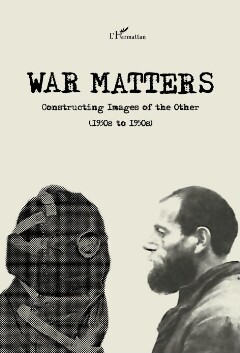Oldal 31 [31]
Constructing Images of the Other in Peace and War
distorted anti-German way (Ponsonby 1991: 65—93). After the end of that war
Hitler in his famous rant Mein Kampf (1974 [1925-1926]: 165-168) expressed
his admiration for Britain’s propaganda representing the Germans as barbarians
and Huns and contrasted it with what he saw as its feebler German and Austrian
counterparts. Propaganda posters designed for the state have a single, aggressive
purpose, far more direct and lacking ambiguity than is the case for cartoonists,
unless they are under direct control, as, say, Stalin’s favourite cartoonist the won¬
derfully talented Boris Efimov was. In the Anglo-Saxon countries the image of the
savage ape (see Fig. 2) was used as a way of getting men to enlist as volunteers or
people to lend money (Bryant 2006: 111) to finance a war that did not directly
concern them and which, a reasonable man would have realised, they should never
have entered in the first place (Ponsonby 1991).
The images were also sometimes used in cartoons and had a new lease of life
in WWII. In peacetime the German image had been quite different even though
there was very strong economic rivalry between Britain and Germany, exacerbated
by the high tariffs placed by the Germans on British exports at a time when Britain
allowed free trade; in British cartoons such as Figure 3 the German economic rival
was shown as a plump merchant contentedly smoking a distinctively German pipe
(Philippe 1982: 210-211).
Making the enemy look simian is a fairly standard response to a violent conflict.
When there were periodic violent conflicts in Ireland in the mid to late nineteenth
century over sovereignty particularly at the time of the Fenian outrages in the
1860s, the Conservative and Unionist illustrated periodical Punch used similar
images of the Irish (Curtis 1971) as in Figure 4 in which an Irishman wearing a hat
labelled ‘Anarchy’ confronts Britannia in her helmet who is comforting a weeping
Hibernia and holding a sword inscribed The Law.
British Marxists and Republicans (Curtis 1985) have labelled these images as
‘racist’. They are not. They are a standard image used when there is a strong politi¬
cal conflict of any kind not just between nations but between political factions.
Hibernia, the female image of Ireland used by Punch, does not look simian (Wynn
Jones 1971: 195), nor would Castle-Catholics or Irish RICs have been portrayed in
this way, but only those who were violently trying to destroy the union of Ireland
with Britain. Conan Doyle (the inventor of Sherlock Holmes and his opponent
the Irish villain Moriarty, whom he based on Nietzsche) was of Irish descent and
a staunch Unionist. No one ever used Conan Doyle’s ancestry or race against him,
as they would have done in an anti-Semitic country, indeed in Ireland itself, if
he had been Jewish. Conflicts between nations are often just that, conflicts over
territory or sovereignty without any underlying sinister ideology being involved.
When the British conflict with Ireland receded, the savagely apish image reverted
to being benign and is often linked to portrayals of the unskilled Irish immigrants
with a long upper-lip, working with pick and shovel (McLachlan 1973) or in so¬
cial controversies involving equally long upper-lipped Irish-American priests and
29

